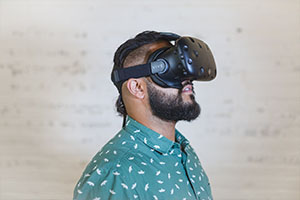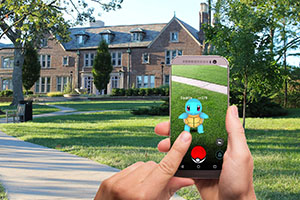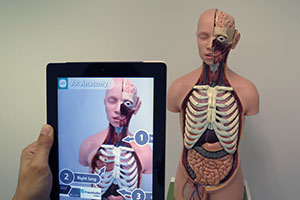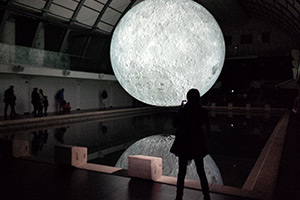


What is VR and AR, and where are they heading?
10/09/2019
Virtual Reality - or VR as it’s commonly called - uses digital technology to create a simulated environment (a virtual world that doesn't really exist), which for now can be  viewed through head-mounted displays. These look like large goggles with a large screen inside, which immerses you into a new world. Unlike the headsets you may have seen over the past decades, VR technology is becoming so advanced that now, not only can you see this new world, but you can also move around in it, move objects, hear what’s happening... and even smell things.
viewed through head-mounted displays. These look like large goggles with a large screen inside, which immerses you into a new world. Unlike the headsets you may have seen over the past decades, VR technology is becoming so advanced that now, not only can you see this new world, but you can also move around in it, move objects, hear what’s happening... and even smell things.
Augmented Reality - or AR - is similar to Virtual Reality, but what you see is based on the real world, in real time, rather than a simulated environment. An AR experience generally involves a device with a camera (such as a smart phone or tablet) that captures the real world around you but superimposes (or augments) additional information into your field of vision. Most of the popular social media apps, such as Snapchat, Instagram and Facebook use AR to add fun overlays to selfies. Using AR you can add a pair of bunny ears and nose onto your face or have your face put onto a dancing baby!
Where are these technologies now?
VR is becoming popular in the world of video games, immersing you into a make-believe environment where you might be fighting zombies or leaping from building to building, while you interact with objects and people around you in the virtual world. Videos and films are also becoming increasingly captivating, putting you into a virtual first-person perspective of someone else in scenes. You could be swimming with sharks, floating about in space, riding a roller coaster or simply enjoying some beautiful scenery from around the world. This is also being used to help people who are unable to move due to disabilities or old age, to stimulate them and let them see the world.
 As mentioned before, AR is commonly used in social media apps for adding objects to your selfies. It is also popular in games such as the massively popular Pokémon Go, where you walk around looking for monsters to catch with your mobile phone. Furniture stores such as Ikea have apps that let you place furniture in your home using your smart phone or tablet, so you can see if it will fit or look right in your room. AR is being used in classrooms too, so students can see inside the human body, or how the change in climate could affect the planet.
As mentioned before, AR is commonly used in social media apps for adding objects to your selfies. It is also popular in games such as the massively popular Pokémon Go, where you walk around looking for monsters to catch with your mobile phone. Furniture stores such as Ikea have apps that let you place furniture in your home using your smart phone or tablet, so you can see if it will fit or look right in your room. AR is being used in classrooms too, so students can see inside the human body, or how the change in climate could affect the planet.
Where is it expected to go?
Virtual Reality has really only just begun to gain mass-appeal now that the technology is advanced enough to create high-quality experiences. It is now developing so rapidly that VR is becoming more and more realistic all the time, although the equipment to enjoy this effectively is still fairly clunky and expensive. Plans to develop the technology further hope to slim down VR devices, as well as removing the need for sensors to be placed on your body and for a handheld controller to be required to interact with objects. Sensors would instead be built into the headset which can detect the depth of where you and where your hands are in relation to everything else around you.
Developers are hoping to use VR not only for entertainment purposes, but also for training too. The technology is already being trialled  to teach surgeons how to operate and allow them to practice in a super-realistic way. VR is also being used to teach people how to fly in a more immersive way than flight simulators can. In coming years we can expect to see VR introduced to more and more places, such as museums and educational attractions where for example, you could walk into an ancient Egyptian themed room and be taken deep into a pyramid, or experience how ancient civilisations lived day-to-day.
to teach surgeons how to operate and allow them to practice in a super-realistic way. VR is also being used to teach people how to fly in a more immersive way than flight simulators can. In coming years we can expect to see VR introduced to more and more places, such as museums and educational attractions where for example, you could walk into an ancient Egyptian themed room and be taken deep into a pyramid, or experience how ancient civilisations lived day-to-day.
AR has been around for some years now, and is arguably more developed than VR currently is since it is already in use on most smartphones and tablets. AR is already increasingly used in retail, particularly in the fashion industry, and will likely continue to change the way we shop in the future. For example, changing rooms could feature AR mirrors that superimpose clothing on to you without even having to get changed.
 Similar to VR, museums and educational environments are likely to use more and more AR in the future, where for example you could use your smartphone to look at an exhibition and view more information about it or even bring it to life. Equally, the medical world is exploring how this technology can help deliver better care. There is an app currently being developed that will analyse whether a child needing an MRI scan will be capable of sitting still for long enough for the scan to take place, or whether they need to be anaesthetised, thus hopefully reducing the number of children needing to be anaesthetised unnecessarily.
Similar to VR, museums and educational environments are likely to use more and more AR in the future, where for example you could use your smartphone to look at an exhibition and view more information about it or even bring it to life. Equally, the medical world is exploring how this technology can help deliver better care. There is an app currently being developed that will analyse whether a child needing an MRI scan will be capable of sitting still for long enough for the scan to take place, or whether they need to be anaesthetised, thus hopefully reducing the number of children needing to be anaesthetised unnecessarily.
As AR and VR are such rapidly growing industries, it will be interesting to see how they integrate with our everyday lives and environments over the next five to ten years.
